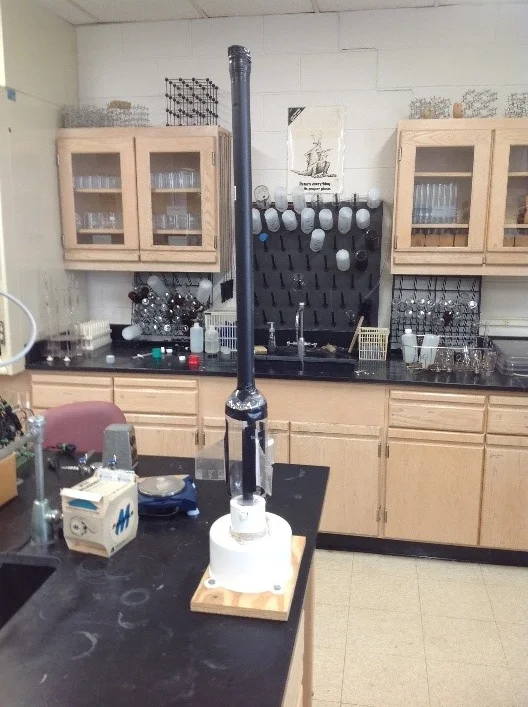NERDS Inc works everyday to improve our product and your experience. We appreciate the insight that Caldwell Early College High School has provided us and we are addressing this development with newly design launch pad. More detail will be out shortly.
A Surprising “Hidden” Variable in 2018 NCSO
Ping-Pong Parachute Launches
Rachel Hagen, Sarah Hedrick, and Michael Leonowicz
Caldwell Early College High School and Caldwell Community College & Technical Institute
Introduction
The Caldwell Early College High School (CECHS) team participated in the North Carolina Science Olympiad (4) (NCSO) 2018 Northwest Regional Tournament on Saturday, March 10, 2018, at Catawba Valley Community College (CVCC) in Hickory, NC. The team, coached by the Caldwell Community College & Technical Institute (CCCTI) Science Club members and staff, placed second overall and was invited to the State Tournament held on Saturday, April 20, 2018, at the North Carolina State University campus in Raleigh, NC. A newly-redesigned rocket for the Ping-Pong Parachute competition performed well in tests at the CCCTI campus (rising 26 - 28 feet), but the rocket rose only 5 - 6 feet at the state tournament despite using comparable launch pressures (~ 35 psi). The CECHS rocket was significantly heavier than most other entrants in the competition, leading to the suggestion that perhaps the CCCTI launcher gauges were significantly under reporting the launch pressures. Subsequent calibration tests showed that the launcher gauges were not significantly wrong, so experiments were undertaken to determine the cause of this discrepancy. This paper details the tests that identified the cause and explains why the CECHS rocket underperformed at the state tournament.
The Ping-Pong Parachute event involves launching a bottle rocket lifting a ping-pong ball that separates from the rocket and returns to earth with a “recovery device,” (usually a parachute); the ping-pong ball’s maximum time aloft is the criterion for adjudging the winner. The 2018 NCSO competition (4) was unusual when compared with those in previous years in that the competition was held indoors, severely limiting the maximum height that the rocket could achieve (~ 26 feet at the state tournament). The maximum pressure vessel size was reduced from two liters to one and the maximum launch pressure was capped at 40 psi. And, significantly, no water could be used to launch the rocket.
Experimental
The tests at CCCTI used an “EZ-Launch (5) Pop Rocket Launcher” similar to the one shown in Figure 1, while the state tournament competition employed a “Nerdsinc (6) Launcher” like the one shown in Figure 2. In tests done in previous years, launches using the EZ-Launch rocket launcher gave results comparable with the device used in the regional tournament, although it should be noted that those launches all involved water as a propellant (in addition to pressurized air) and the launcher used in the region tournament had a significantly longer launch tube (vide infra) than that used in this year’s competition (7).
Figure 1: EZ-Launch Pop Rocket Launcher
Figure 2: NERDS Inc Launcher
The bottle rocket used in the state competition consisted of a one-liter club soda8 pressure vessel with fins and a nose cone constructed from other club soda bottles. A golf-club bag club tube (9) was affixed to the nose cone to shift the center-of-mass toward the top of the rocket. A heavy mass (10) was inserted into the top of the tube to further enhance the shift of the center-of-mass towards the top of the rocket. Consequently, the mass of the new CECHS rocket was significantly greater than previous designs. The rocket used in the state competition is shown in Figure 3.
FIgure 3: CECHS Rocket used at the NCSO State Tournament
After the disappointing performance of the original rocket used in the Northwest Regional tournament, a complete re-analysis of the 2018 NCSO Ping-Pong Parachute competition rules was conducted. Several conclusions resulted from that study. First the 26-feet maximum height limitation meant that there was insufficient time to allow a complicated recovery device to rapidly deploy a parachute to extend the time aloft; the parachute must be deployed essentially instantaneously upon the rocket achieving its apogee. The solution chosen to achieve this goal was to have the ping-pong ball and its attached parachute at the top of the rocket and to design a rocket that would go straight up, stall, and go straight back down, like a po-go stick; this type of rocket is called a “backslider.”
For those of us who aren’t rocket scientists, it is easy to be amazed by the amount of information known and published about bottle rockets. An important characteristic of backslider designs is having the center-of-gravity (C-o-G) of the rocket well forward of the center-of-pressure11. While the placement of the C-o-G in backslider rockets must be carefully chosen11, placing the C-o-G well forward in the rocket insures that the initial behavior of the rocket upon stalling will be to slide straight back downwards. This behavior was key to launching the ping-pong ball recovery system, which was simply a parachute draped over the tip of the rocket with the attached ping-pong ball placed on top of it. The reasoning behind this design was that the backsliding rocket would immediately “inflate” the parachute, essentially instantaneously deploying the recovery device. In tests using this rocket with an EZ-Launch5 Pop Rocket Launcher (See Figure 4a), altitudes of 26 – 30 feet were easily achieved using a launch pressure of ~ 35 psi and the recovery system immediately deployed as expected.
Figure 4a: Standard EZ-Launch Launch Tube Configuration
Figure 4b: Close-up of NERDS Inc Launcher
Figure 4c: EZ-Launcher Modified Configuration
The performance of the rocket at the NCSO State Tournament was disappointing; it rose only 5 -6 feet despite a launch pressure of ~ 35 psi. Initial suggestions centered on the launch pressure, hypothesizing that the pressure gauges used at CCCTI were seriously in error. However, post-facto measurements (12) showed no such discrepancies, eliminating that possibility.
The other obvious difference between the CCCTI and NC State launches was the type of launcher used; the tournament used a NERDSs Inc(6) Launcher. As shown in Figure 4b, the launch tube (which is inserted into the pressure vessel) on this launcher is much shorter than the standard launch tube used on the EZ-Launcher (Compare Figures 4a and 4b).
To test the importance of the launch tube length on rocket performance, a second launch tube was obtained from the manufacturer(5) and shortened to the length shown in Figure 4c. When the rocket was tested using this configuration, altitudes of only 5 - 6 feet were achieved using ~35 psi air pressure. Surprisingly, the launch tube length was a critical factor that determined the performance of bottle rockets in the 2018 competition.
Analysis
The energy imparted to the bottle rocket is proportional to the work done on it, which is force applied over a distance. The force is the pressurized air in the vessel and the distance is how far the rocket must move until the pressure differential with the atmosphere has been equalized. The seal between the pressure vessel and the atmosphere is the O-ring at the bottom of the launch tube which is ostensibly in the same place in both launchers. But launch tube itself is a pretty tight fit (13) to the mouth of the bottle, limiting the rate at (and distance over) which pressures could be equalized. If the mouth of the pressure vessel is sufficiently large to allow rapid equalization of pressures once the mouth has cleared the launch tube, the distance (time) over which force is applied (and energy imparted) to the rocket should depend on the length of the launch tube.
One might ask why the dependence on launch tube length didn’t surface in previous bottle rocket competitions. One reason is that previous bottle rocket launches were done outside and water was part of the pressure vessel charge. Apparently, the launchers used in these competitions employed relatively long launch tubes (7). Furthermore, the presence of substantial amounts of incompressible fluid (i.e., water) in the pressure vessel could ameliorate the effect of differences in launch tube lengths, as time (distance) needed to expulse this fluid might overwhelm the launch tube length effects. Further experiments could resolve the validity of this hypothesis.
Conclusion
This analysis reveals an unexpected dependence of bottle rocket launches on the nature of the launcher itself, at least when water free launches are attempted. Hindsight is always 20:20, but the lack of previous anomalous results easily explains why this factor was overlooked. But then, the goal of Science Olympiad is learning, not victory, and this competition has achieved its goal.
References and Notes
- CECHS; Email Address: Rachel.hagen2020@gmail.com
- CECHS; Email Address: Sarah.hedrick2020@gmail.com
- CCCTI; Email Address: mleonowicz@cccti.edu; author to whom correspondence should be addressed.
- Web Site: https://www.sciencenc.com/
- Web Site: http://ez-launch.com/
- Web Site: https://www.nerdsinc.com/
- Competition observations and private communications from previous bottle rocket competition participating team members.
- Club soda citation
- Available at most sporting goods stores such as “Academy Sports + Outdoors,” “DICK’S Sporting Goods,” etc.
- A ~4 ½ inch-long ceramic pestle appropriated from the Chemistry lab.
- http://www.aircommandrockets.com/recovery_guide.htm
- Pressures were calibrated using an ACCUTIRE tire pressure gauge.
- Furthermore, a lubricant (e.g. grease) is usually applied to the mouth of the pressure vessel to enhance the seal around the O-ring







